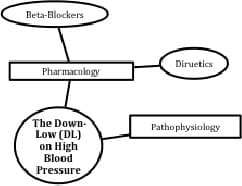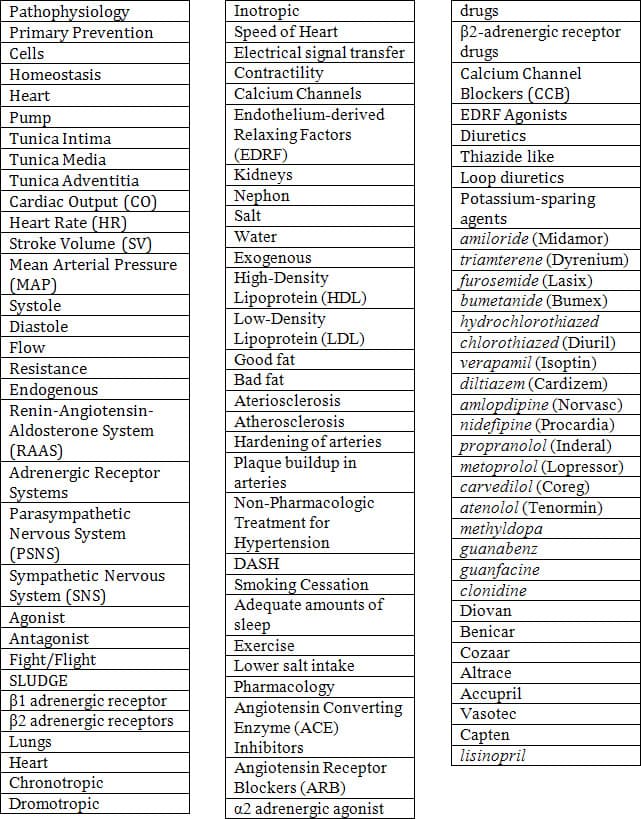Acute Activities
The following activities are designed to each last between one to two 90–minute class periods. There are a total of three acute activities that will last for approximately five to six class periods, or two weeks.
Gatorade Gulping: The Game of Resistance
Time: approximately one to one and a half 90–minute class period
Materials: red Gatorade (premixed in a large container; approximately 24oz needed per person), 5oz cups (one per person), coffee Straws (one per person), regular straws (two per person), Stopwatches (or utilize a projector and screen showing the online stopwatch at www.online–stopwatch.com), paper/pencil, calculator
Alternatives: If a student is allergic, or cannot drink Gatorade, water can be used as a substitute.
Introduction: The purpose of this experiment/demonstration is to show the decrease in flow in relation to the size of the straw. Mathematically, the students can be shown the relationship between flow, resistance, and vessel radius. For example, assume that the radius of the regular straw is one millimeter, and the coffee straw is 0.5 millimeters. Therefore, the double straw will represent two millimeters, the single straw one millimeter, and the coffee straw 0.5 millimeters. Utilizing the equations in Figure 3, the teacher should have the students calculate the resistance created with each straw set. The resulting calculations should show that the two millimeter straw set creates a resistance of 1/16, the one millimeter straw creates a resistance of one, and the 0.5 millimeter straw creates a resistance of 16. The concept of resistance may be difficult at first for some students as it will require them to conceptualize inverses. I believe the best way to overcome this is by practice. Have students do problems with different radii. As they are doing problems, integrate the concept of flow, as an inverse relationship of resistance. Slowly integrate the cardiovascular system into the problems as follows: Patient A has an artery radius of 0.25 millimeters, and Patient B has an artery radius of 0.33 millimeters. Which patient will have a better flow in their artery? I believe it is important for students to not only realize the inverse relationship of resistance and flow, but be able to explain their answer quantitatively. To apply more rigors you may pose the following questions:
- Whose heart has to pump harder to obtain homeostasis?
- What are some causes of decreased artery radius?
- Which straw set do you think contained the most pressure?
- How is flow related to blood pressure?
- In the patients above, who would most likely have a higher blood pressure?
- Challenge Question: If a drug could decrease Patient B's radius by 40%, how much of a change in flow would that cause?
Directions:
- Divide the class into teams of two and distribute materials to each student
- Students will take turns during each round. One student will do the experiment while the other will watch the clock.
- Pour 4oz of Gatorade into each student's cup
- The first round will involve using two regular sized straws. When the teacher says go, the one student will extract the Gatorade out of the cup using the two straws while the other student records the time.
- The students will switch, and repeat step 3.
- Refill 4oz of Gatorade into each student's cup
- For the second round, students will only use one regular sized straw. When the teacher says go, the one student will extract the Gatorade out of the cup using the one straw while the other student records the time.
- The students will switch, and repeat step 6.
- Refill 4oz of Gatorade into each student's cup
- For the final round, students will use a coffee straw. When the teacher says go, the one student will extract the Gatorade out of the cup using the coffee straw while the other student records the time.
- The students will switch, and repeat step 9.
- All data is then be collected by the teacher (or a selected teacher assistant), and the mean time for each step can be calculated. This step can be extrapolated to discuss statistical analysis of data.
Note: This example of flow and resistance is a gross oversimplification of vessel pathophysiology. More advanced students (especially those who have taken physics), may bring up the point of the resistance formula being incorrect. In order to more easily teach resistance and flow, I have made assumptions in the formulas. For example, I am assuming the viscosity of the liquid (blood) remains constant, the length of the vessel (the cardiovascular system) doesn't change, and the surface of the vessels (i.e. the amount of drag) doesn't change. Furthermore it should be emphasized that the experiment was a demonstration of negative pressure, while the arterial system works by positive pressure changes created from the heart.
Mapping Out Medicine
Time: approximately two 90–minute class period
Materials: pencil, colored pencils and/or markers, large paper (8½" x 14") or larger construction paper, list of
Alternatives: This assignment can be completed as homework for more advanced students if desired by the teacher
Introduction: The mind works as a series of a millions connections inside your brain. Learning occurs in making and strengthening these neuronal connections. The purpose of this activity is to build connections to the topics discussed in this unit. Students will first need to be introduced to the concept of a mind web (if not already familiar). Once familiarized, students will be given a list of concepts that need to be linked together utilizing a mind web. When introducing this activity, I highly suggest presenting it as a puzzle that needs to be solved. Technically there is only one right answer; however, there are multiple ways of creating that answer. To add rigor to this activity, teachers will highlight certain pathways on students' mind maps (once completed) and require a written explanation.
Directions:
- Using a pencil, start by creating a circle, in the middle of the page, with the title of the unit written inside: "The Down–Low (DL) on High Blood Pressure."
- The students will then utilize the words from the list below to create a web that branches off the initial circle. For example:

- Once students have created a web with all key words, have them add color and pictures. The students should be free to be as creative as possible. They should not be restricted to using only circles boxes, or connecting only two items. Their web can be graded not only on content, but also on the amount of effort put forth.
- To add rigor to this assignment, once completed, the teacher can highlight (literally or figuratively) one pathway along the student's web. The student is then instructed to write, in paragraph form, what they know about this pathway. The teacher can direct the amount of writing that is required. For example:
- >Highlight: DL on High Blood Pressure – Pharmacology – Beta Blockers
- >Students Write: High blood pressure can often be controlled by pharmacological agents. One very common agent is beta–blockers. Beta–blockers work by blocking the beta–adrenergic receptors found on the tunica intima of blood vessels. Blocking these receptors causes vasodilation, which in turn can lower overall blood pressure.
While this list covers all topics discussed in the background information, I would recommend selecting words that you have covered in your class discussion.

What's in YOUR Medicine Closet?
Time: approximately two 90–minute class period
Materials: computer with Internet access for each group/student, color printer, paper/pencil
Alternatives: Have students research a medication that someone in their family is currently taking for high blood pressure. The student should describe the medication via writing or drawing, and bring this writing/description into class on the day of this activity. This should not be mandatory, as not all students will have family members using hypertension medications.
Introduction: Although this activity requires some preparation on the part of the teacher, it can be a great culminating activity for the end of unit. During this activity students will utilize a website to identify medications from given pictures. When it comes time to have students research their medicines, I would recommend utilizing the website http://pillbox.nlm.nih.gov/bin–release/PillBox.php. This website, run by the National Library of Medicine (NLM), is very interactive and easy to maneuver. If, for some reason, that site doesn't run on an older computer, NLM has a more browser friendly site at http://pillbox.nlm.nih.gov/pillimage/search.php. After students have identified all the medications, they will then research a hypertension medication of their choosing. Teachers have the option of making this into a project, with PowerPoint, a written assignment, and/or boards. ,
Directions:
1. Using the list from the previous activity, and Google images, print out pictures of medications commonly used for treating hypertension. When printing these pictures, ensure their quality is decent enough to distinguish color, shape, and imprints on the pill (if applicable). Number each picture and create a key that can be used later for grading purposes. Create enough pictures so that there is at least one per student, with more being preferable.
2. Have students access the website http://pillbox.nlm.nih.gov/bin–release/PillBox.php, or alternatively http://pillbox.nlm.nih.gov/pillimage/search.php.
3. On a sheet of paper, list out the number of medications you have prepared. For example, if you have 20 medications, students should write one through twenty, one number per line.
4. Spread the pictures on a table, and have students pick out their own medication.
5. Have the students utilize the website to identify the pill.
6. Students should write the medication name, both trade and brand if applicable, on their paper.
7. Once students have finished identifying and recording the medication, they should return the medication photo and obtain another until all photos have been identified.
8. To add rigor to this activity, students could then select a specific hypertension medication. This selected hypertension medication can be one that a family member takes, one that they have previously seen on TV, or one at random. The student will then write a two–three paragraph summary of the drug. Information on the medication can be found on the NLM website. The paragraphs should focus on the following items:
a. Name (trade, brand, and chemical if applicable)
b. Manufacturer(s)
c. Description of the medication (color, shape, etc.)
i. There may be different descriptions for each dosage. Students should list all.
d. Mechanism of action
- i.How it works in the body?
- ii.What does it stimulate, antagonize, etc.
e. Why is it prescribed?
f. Who it is prescribed to?
g. What are the side effects?
h. What are the contraindications?
i.Contraindications are reasons the medication should not be prescribed. For example: Pregnancy is a contraindication for the medication Accutane. Those people who are pregnant should not be prescribed Accutane.
i. Are there are any other uses for the medication?
i.Some medications are used for multiple reasons, for example, metformin (Glucophage) can be used for both type two diabetes and women with polycystic ovary syndrome (PCOS).
j. How much does the medication cost?
i.This is what it would cost the consumer to buy without insurance. This is not a copay amount.

Comments: